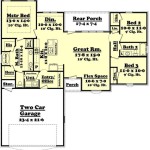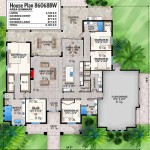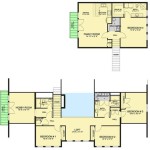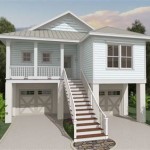Southern Living House Plans: The Allure of Double Porches
Southern Living house plans are often admired for their classic architectural details, functional layouts, and undeniable charm. Among the most beloved features found in these designs is the double porch. These stacked porches, typically found on the front of the house, offer not only aesthetic appeal but also practical living spaces that enhance the Southern lifestyle. This article delves into the characteristics, benefits, and design considerations of Southern Living house plans featuring double porches.
The double porch design is deeply rooted in Southern architectural history. Historically, these porches provided shade from the intense Southern sun and allowed for natural ventilation, crucial before the advent of air conditioning. They served as social gathering places, extending the living space outdoors. The upper porch, often accessible from bedrooms, offered a private retreat, while the lower porch facilitated interaction with neighbors and passersby. Modern Southern Living house plans adapt this traditional design, incorporating contemporary materials and building techniques while preserving the aesthetic and functional essence.
Double porches are not merely decorative elements; they are functional extensions of the home. They provide shaded outdoor living spaces that can be enjoyed throughout the year in many Southern climates. The design contributes to the architectural character of the house, enhancing its curb appeal and reflecting the Southern aesthetic. The strategic placement of porches can also influence the energy efficiency of the home by providing shade and reducing solar heat gain.
Key Point 1: Architectural Styles and Double Porch Integration
Double porches are versatile and can be incorporated into a variety of architectural styles commonly found in Southern Living house plans. These include, but are not limited to, the following:
Charleston Style: Perhaps the most iconic example, Charleston-style homes frequently feature double porches that span the entire front facade. These porches are often adorned with intricate railings, columns, and decorative trim, reflecting the historic elegance of the city. The color palette typically involves muted tones, such as whites, grays, and light yellows, further enhancing the classic appeal.
Greek Revival: This style often incorporates grand, imposing columns that rise to support a substantial roofline. Double porches in Greek Revival homes are typically more formal in appearance, often featuring symmetrical designs and classical detailing. The use of stark white paint is common, emphasizing the architectural lines and creating a sense of grandeur.
Farmhouse Style: Double porches in farmhouse-style homes tend to be more relaxed and informal. They may feature simpler railings, exposed wood, and comfortable seating arrangements. The use of natural materials and muted colors contributes to the rustic and inviting atmosphere.
Coastal Cottage: Coastal cottage designs often incorporate double porches with a more casual and airy feel. The use of lightweight materials, such as wood lattices and nautical-inspired details, is common. Colors are typically bright and vibrant, reflecting the coastal surroundings.
The successful integration of a double porch into a Southern Living house plan requires careful consideration of the architectural style and the overall design aesthetic. The porch should complement the other architectural elements of the house, creating a cohesive and harmonious appearance.
The specific design of the double porch can be customized to suit the homeowner's preferences and lifestyle. For example, a homeowner who enjoys entertaining may opt for a larger lower porch with ample seating and dining space. A homeowner who values privacy may prefer a smaller upper porch that is accessible only from the master suite. The possibilities are virtually endless, allowing for a truly personalized living space.
Key Point 2: Functional Benefits of Double Porches
Beyond their aesthetic appeal, double porches offer several functional benefits that enhance the livability of a home. These benefits include:
Enhanced Outdoor Living Space: Double porches extend the living space outdoors, providing comfortable areas for relaxation, entertaining, and enjoying the surrounding environment. The upper porch offers a more private retreat, while the lower porch facilitates social interaction with neighbors and guests.
Improved Ventilation: The placement of double porches can promote natural ventilation, helping to keep the home cool and comfortable, especially during warmer months. The porches provide shade, reducing solar heat gain and allowing for cross-ventilation through open windows and doors.
Increased Curb Appeal: Double porches significantly enhance the curb appeal of a home, creating a welcoming and inviting appearance. The architectural detail and visual interest added by the porches can increase the perceived value of the property.
Weather Protection: The upper porch provides shelter for the lower porch, protecting it from rain and sun. This allows the lower porch to be used more frequently, even during inclement weather. The overhang created by the porches also helps to protect the walls and windows of the house from the elements.
Privacy Control: Double porches can provide a buffer between the interior of the home and the outside world, offering a sense of privacy and seclusion. The upper porch, in particular, can serve as a private retreat that is shielded from public view.
The functional benefits of double porches make them a valuable addition to any Southern Living house plan. By providing enhanced outdoor living space, improved ventilation, increased curb appeal, weather protection, and privacy control, double porches contribute to a more comfortable and enjoyable living experience.
Key Point 3: Design Considerations for Double Porches
Designing a double porch requires careful consideration of several factors, including the size and proportions of the porch, the materials used, the railing design, and the overall aesthetic of the home. The following are some key design considerations:
Size and Proportions: The size and proportions of the double porch should be appropriate for the size and style of the house. A porch that is too large or too small can detract from the overall aesthetic. The height of the porch should also be considered, ensuring that it provides adequate headroom and visual appeal.
Material Selection: The materials used for the double porch should be durable, weather-resistant, and aesthetically pleasing. Common materials include wood, composite decking, brick, and stone. The choice of materials should complement the other architectural elements of the house and reflect the desired style.
Railing Design: The railing design is a critical element of the double porch, contributing significantly to its aesthetic appeal and safety. Railings can be made from a variety of materials, including wood, metal, and composite. The design should be consistent with the overall style of the house and should meet all applicable building codes.
Column Design: Columns are another important architectural element of the double porch. They provide structural support and contribute to the overall aesthetic. Columns can be made from a variety of materials, including wood, brick, and stone. The design of the columns should be consistent with the other architectural elements of the house.
Lighting: Lighting is essential for creating a welcoming and functional double porch. Outdoor lighting can provide safety, security, and ambiance. Consider incorporating a variety of lighting fixtures, such as porch lights, sconces, and recessed lighting.
Furnishings: The furnishings on the double porch should be comfortable, durable, and appropriate for outdoor use. Consider incorporating a variety of seating options, such as chairs, sofas, and benches. Outdoor rugs, pillows, and accessories can add color and texture to the space.
Incorporating a ceiling fan can enhance comfort, especially in warmer climates. Screens can be added to the porch to provide protection from insects.
The careful consideration of these design factors will result in a double porch that is both aesthetically pleasing and functionally beneficial, enhancing the beauty and livability of the Southern Living house plan.
In addition to the above, regional variations in climate and lifestyle can significantly impact the design and functionality of double porches. For example, homes in coastal areas are likely to incorporate materials that are resistant to saltwater corrosion, while homes in hotter climates may prioritize the use of light-colored materials to reflect sunlight. Understanding these regional nuances is crucial for creating a double porch that is both beautiful and practical.
:max_bytes(150000):strip_icc()/oakland-hall-c045deca4ac54736b4d97dd9c7f956b8.jpeg?strip=all)
30 Pretty House Plans With Porches

Southern Living Dreamy House Plans With Front Porches Blog Dreamhomesource Com
These All Time Best Southern Living House Plans Are Certified Dream Homes

Our Favorite House Plans With Wrap Around Porches Porch Southern Wraparound

Southern Living Dreamy House Plans With Front Porches Blog Dreamhomesource Com
Our Favorite House Plans Of 2024
:max_bytes(150000):strip_icc()/southern-living-house-plans-lowcountry-4556fed3ac7c4d60a792d0382236befd.jpg?strip=all)
Modern Farmhouse Was The Most Popular Home Style Of 2024 5 Inspiring Design Plans

Southern Living Dreamy House Plans With Front Porches Blog Dreamhomesource Com

The Loudon Sl 2054 House Plan By Bridgewater Architectural Design For Southern Living Plans Cottage
Our Charming Banning Court House Plan Is Like Stepping Inside A Storybook








